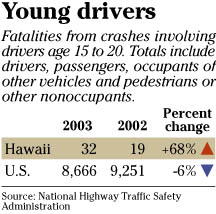— ADVERTISEMENT —


|
Isles buck fatal
crash trend
While most states saw fewer crashes
involving young drivers in 2003,
Hawaii’s numbers rose
Fewer people died in automobile crashes involving young drivers nationwide in 2003, but Hawaii bucked that trend and a state official blames an "alarming" increase in alcohol-related accidents.
 While most states saw a decrease from 2002 in fatalities involving drivers between the ages of 15 and 20, Hawaii was one of 14 states that saw an increase, according to National Highway Traffic Safety Administration statistics released today.
While most states saw a decrease from 2002 in fatalities involving drivers between the ages of 15 and 20, Hawaii was one of 14 states that saw an increase, according to National Highway Traffic Safety Administration statistics released today.
In Hawaii, 32 people were killed in fatal crashes involving young drivers, a 68 percent increase from 19 people the year before, the federal government said.
In addition, state Department of Transportation statistics show that young people also made up more of the passengers in fatal crashes.
State officials said of the 133 people who died in traffic fatalities last year, 42 of them were between 15 and 24, the most of any age group.
"We had a lot of horrible crashes last year involving our youth -- a lot of them alcohol-related," said Transportation Department spokesman Scott Ishikawa. "What happens is you have groups of kids riding together and the driver is drinking, and unfortunately it's resulted in multiple deaths."
Ishikawa said of the 42 deaths involving youths, 31 were killed in alcohol-related crashes.
"It's alarming," he said.
According to the federal statistics, the nationwide total for fatalities involving younger drivers -- including their passengers, people in other vehicles and pedestrians -- fell 6.3 percent to 8,666 in 2003 from 9,251 in 2002.
The number of young drivers who died also decreased 4.4 percent nationwide, to 3,657 deaths in 2003 from 3,827 the previous year.

|
The federal data also show an overall steady decline in alcohol involvement in crashes among young people. Alcohol was a factor in 25 percent of the fatal crashes involving young drivers last year. In 1993 one in three such accidents was alcohol-related.
"People are starting to ask why. There was a time we expected we would lose some members of our high school class because of a car crash, but people are understanding that it doesn't have to be that way," said NHTSA's chief, Dr. Jeffrey Runge.
Runge said parents should limit nighttime driving. Studies also show that limiting the number of passengers in young drivers' cars also cuts down on accidents, Runge said.
Barbara Harsha, executive director of the Governors Highway Safety Association, said the decline in the number of young drivers killed last year might be due to the growing attention paid to real-world skills in driver-education classes.
More people also wore seat belts last year, and that could have saved many young drivers. The government said that 72 percent of people age 16 to 24 buckled up last year, compared with 65 percent in 2002.
The agency found that the percentage of young female drivers involved in fatal crashes has grown faster than the rates for males since 1993. Women represented 28 percent of the young drivers killed in 2003, compared with 25 percent in 1993.
In Hawaii, Ishikawa said the state will concentrate on making roads safe by keeping those driving under the influence of alcohol off the streets.
In November a campaign will start that involves all four county police departments setting up DUI checkpoints once a week for the next year.
"Everybody knows the DUI checkpoints are out there when there's a three-day weekend," he said. "This way, we shake things up a bit."
The Associated Press contributed to this report.
— ADVERTISEMENTS —
— ADVERTISEMENTS —